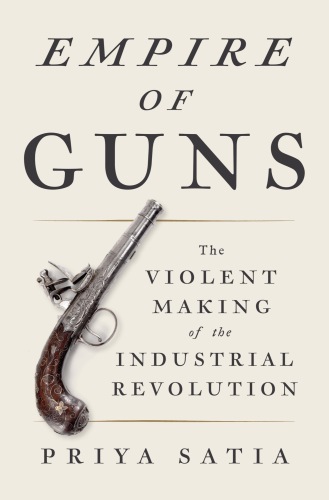
Empire of Guns
The Violent Making of the Industrial Revolution
کتاب های مرتبط
- اطلاعات
- نقد و بررسی
- دیدگاه کاربران
نقد و بررسی

February 5, 2018
Stanford history professor Satia (Spies in Arabia) hastily probes the relationship between war and industrialization in 18th-century Britain using the story of Samuel Galton Jr., a prominent Birmingham gun manufacturer. In 1795, Galton was accused by his fellow Quakers of promoting an immoral trade in the manufacturing of guns. In response, Galton claimed that gun-making could not be isolated from the British industrial economy of the time—which had grown out of Britain’s nearly continuous state of war over the past century. Satia uses Galton’s defense as a window into the central role of the arms industry in precipitating the Industrial Revolution. She goes on to argue that indeed it was changes in the nature of violence and the social role of guns in the age of British imperialism that provided the impetus for state-driven industrialization. Yet she provides little evidence for her sweeping claims, failing to address the fact that perpetual warfare was a reality for all European states during the era, not just Britain, and paying scant attention to shifts in agricultural production and demography that were critical to industrial takeoff. Nor does she engage with scholars who argue that the state served as a barrier, rather than an impetus, to industrialization. This book eschews the big picture for a series of stylized historical set pieces.

February 15, 2018
Mr. Owen, meet Mr. Colt: a wide-ranging if overlong history of the role of arms manufacturing in the Industrial Revolution.The rise of mechanized industry in Britain, writes Satia (History/Stanford Univ.; Spies in Arabia: The Great War and the Cultural Foundations of Britain's Covert Empire in the Middle East, 2009), corresponded to a period of "more or less constant war." There was always France to fight, of course, but also the rebellious American Colonies and uprisings elsewhere in the empire, and the Dutch and the Spanish. An economy flourished, therefore, in the manufacture and sale of armaments and other military provisions. One of Satia's perhaps unlikely case studies is Samuel Galton, a nominally good Quaker who managed to reconcile that belief system with making a fortune in weaponry. Then as now, the arms merchants were not especially particular about where their products wound up. As Satia observes, in the 18th century alone, millions of guns sprang forth from workshops and factories in the Midlands and London, winding up in the hands of buyers everywhere in the world; in 1715, "the government discovered that London gunsmiths were making 15,500 guns," with some 4,000 of them "for Service not Known," as a contemporary document put it. A century later, and more than 151,000 British guns were bound for India, Indonesia, and China. This early military-industrial complex also valued interchangeability, standardization, and mass production, which would come to define the manufacture of nearly everything else. While standardization was not commonplace until after the Crimean War, it was at a premium well before. After 1815, Satia writes, the gun business faded somewhat as slavery wound down, for the slave trade was bound up part and parcel in armaments. She closes with a sharp look at today's mass shootings, which she considers "historically specific"--i.e., the product of a time in which guns are used for private grievances more than empire-building.A solid contribution to the history of technology and commerce, with broad implications for the present.
COPYRIGHT(2018) Kirkus Reviews, ALL RIGHTS RESERVED.

March 15, 2018
In her second book, Satiya (history, Stanford Univ.; Spies in Arabia) draws on the archives of British gun manufacturing family, the Galtons, to argue a different story as to how and why the Industrial Revolution began in the British Isles in the 18th century. The time period was a century of near constant wars, and wars required weapons. Thus, the government was drawn into weapons manufacturing. Standardization of parts and improved reliability (e.g., better grade iron) were important to the government; mechanization and use of more efficient power sources much less so. The recurring conflicts of the century and the use of guns as trade objects in Africa and other continents increased demand and industrialization. Satiya thoughtfully questions how the Galtons rationalized their involvement in the gun trade and why their Quaker brothers were so late in condemning them for it? What was the psychological import of bearing weapons in Africa and India? When did gun violence become a domestic issue in England and why? VERDICT Satiya's latest work has much to offer history readers, both casual and academic. As a bonus, it's exceptionally crafted.--David Keymer, Cleveland
Copyright 2018 Library Journal, LLC Used with permission.

























دیدگاه کاربران